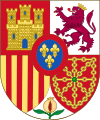Instituto San Isidro
Instituto San Isidro is a co-educational day school for pupils from 12 to 18 years of age. It is located in the historical Calle de Toledo in Madrid, Spain.
| Instituto San Isidro | |
|---|---|
_01_var.jpg) Facade of Instituto San Isidro in Calle de Toledo | |
| Address | |
Calle de Toledo 39 , 28005 | |
| Information | |
| Type | State-funded |
| Established | 1845 |
| Head Master | Enrique de Avilés y Arroyo |
| Director of Studies | Rafael de Martín y Villa |
| Gender | Coeducational |
| Age | 12 to 18 |
| Colour(s) | Imperial roseate & pantone |
..jpg)
It is one of 66 secondary schools established in provincial capitals and other major cities under the 1836 Plan General de Instrucción Pública. Most of these schools occupied the premises of disentailed convents and other church buildings.[1] Originally a boys' school, it became coeducational and state-owned in the second half of the 20th century. The school occupies part of a site belonging to several earlier schools, indirectly tracing its origins to 1346, and is considered the oldest non-university education center in Spain.[2]
San Isidro has educated eight Spanish prime ministers and was formerly referred to as the "nanny" of Spain's statesmen.[3][4] With the discovery of the Americas, the school gained importance in educating young men who would later become a credit to the Spanish Empire.[5] It has four Nobel Prize laureates among its alumni: José Echegaray, Jacinto Benavente, Vicente Aleixandre, and Camilo José Cela.[4]
Heritage
The school occupies part of the site[6] originally belonging to several former education centers, including the Reales Estudios de San Isidro (1625–1809), formally known as the Colegio Imperial (c. 1590–1625).[7] It was built on land donated by Empress Maria of Austria.[8][9]
The current building includes the baroque cloister (1672), a baroque staircase and an elegant chapel (1723). On the stairs is a small museum dedicated to science and education.[10]
From 1847 to 1936, Madrid's School of Architecture (Escuela Especial de Arquitectura, now Superior Technical School of Architecture of Madrid, ETSAM) occupied part of the premises of the Institute, together with the secondary school and other schools and departments.[11] In 1936, it moved to its current site at Ciudad Universitaria.[12][11] The School of Architecture's coat of arms remain over the main entrance to the Institute.[11]
The school has a museum on the ground floor with a recreation of a school class and four floors of various interests.[13]
Notable alumni
The former pupils of San Isidro are known as "Old Franciscans". The school has educated a wide range of notable figures including four Nobel Prize laureates[4][14] and eight Spanish prime ministers.[3] Many old pupils went on to fight in the Spanish Civil War, the great majority of them joining the Nationalist side, with around 200 being killed during the two-year conflict. In addition, 12 Old Franciscans from the Blue Division died fighting in the Eastern Front during World War II.[15]
See also
- List of the oldest schools in the world
- List of Nobel Prize Laureates by secondary school
- Colegiata de San Isidro
- Colegio Imperial de Madrid
References
- Escolano Benito, Agustín (in Spanish). "Review: El Instituto de San Isidro. Saber y patrimonio. Apuntes para una historia. González de la Lastra, Leonor y Fernández Bargueño, Vicente J. (eds)." Fundación madri+d. Retrieved 21 January 2019.
- Martín Villa, Rafael (in Spanish). "Centros Escolares con Patrimonio Histórico: IES San Isidro, Madrid". Participación Educativa, 7 (March 2008). Ministry of Education (Spain). Retrieved 21 January 2019.
- "Overview of Former pupils of the Instituto San Isidro". Retrieved 2016-10-13.
- Betim, Felipe. "Un colegio con cuatro Nobel". El País. Retrieved 2016-10-13.
- Thomas, Hugh. El Imperio Español de Carlos V (2010).
- Gea, María Isabel. Los nombres de las calles de Madrid, p. 109. La Librería, Madrid 2009. 978-84-87290-94-7
- "El Colegio Imperial de Madrid y los Reales Estudios de San Isidro." Biblioteca Histórica Marqués de Valdecilla. Universidad Complutense Madrid. Retrieved on 21 January 2019.
- Ortega & Marín 2013, pp. 140-143.
- Répide, Pedro de. Las calles de Madrid, p. 258. Ediciones La Librería, Madrid 2011. 9788487290909
- "School museum".
- Prieto González, José Manuel (in Spanish). Aprendiendo a ser arquitectos: Creación y desarrollo de la Escuela de Arquitectura de Madrid (1844-1914), pp. 201-4. Editorial CSIC - CSIC Press, 2004. Google Books. Retrieved 21 January 2019.
- "Historical background." Superior Technical School of Architecture of Madrid. Retrieved 21 January 2019.
- "Areas of interest at Instituto San Isidro".
- "Old alumni". Archived from the original on 2016-03-12. Retrieved 2016-03-11.
- González de la Lastra, Leonor; El Instituto San Isidro: Saber y Patrimonio, Apuntes para una Historia (2014).
Bibliography
- Ortega Vidal, Javier; Marín Perellón, Francisco José. "La conformación del Colegio Imperial de Madrid (1560-1767)." Anales del Instituto de Estudios Madrileños, LIII, pp. 135–175. Madrid, 2013
- Fernández-Burgueño, Vicente, El Instituto San Isidro: Saber y Patrimonio, Apuntes para una Historia (Madrid, Editorial CSIC, 2013, ISBN 978-84-00-09776-9)
- Díaz, José Simón, Historia del Colegio Imperial de Madrid: Volúmenes I y II (Madrid, Instituto de Estudios Madrileños, 1959, ISBN 978-84-00-07148-6)
External links
| Wikimedia Commons has media related to Instituto San Isidro. |
